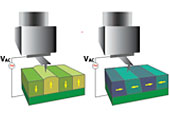
Scientific Digest 105d
Piezoresponce Force Microscopy (PFM) is an AFM mode which probes the mechanical deformation of a sample in response to an electric field which is applied between tip and sample. It allows to visualize ferroelectric domains, perform direct measurement of piezoelectric coefficients, study the dynamics of domain walls, etc. with high spatial resolution. These studies are essential for understanding the nature of new functional materials and devices for optoelectronics, data storage, medical diagnostics, actuators, etc.
pdf
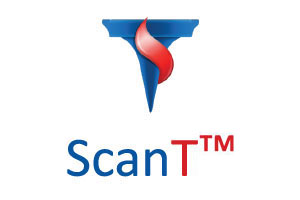
Application Note 104
Atomic Force Microscopy is not simple to use, which elicits varied results between researchers with different levels of experience. NT-MDT Spectrum Instruments (formerly NT-MDT) have created the intelligent software, ScanT™, inspired by neural networks to make dynamic amplitude modulation AFM (AM-AFM) easy for researchers of every skill level.
pdf
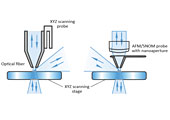
Scientific Digest 103d
Scanning near-field optical microscopy (SNOM) enables studying a sample’s optical properties with resolution far beyond the diffraction limit. Sample fluorescence, light emission, transmission, scattering etc. can be mapped with the spatial resolution down to tens of nanometers.
pdf (1.5 Mb, EN)
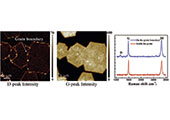
Scientific Digest 102d
Integration of AFM with confocal Raman/fluorescence microscopy provides wide range of physical and chemical information about the sample. Simultaneously measured AFM and Raman maps of exactly the same sample area provide complementary information about sample physical properties (AFM) and chemical composition (Raman).
pdf (1.1 Mb, EN)
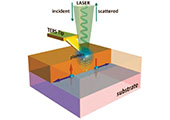
Scientific Digest 101d
Tip-Enhanced Raman Scattering (TERS, nano-Raman) is the technique for enhancement of weak Raman signals and for super-resolution Raman imaging with spatial resolution ~10 nm. Nano-Raman imaging provides unique insights into sample structure and chemical composition on the nanometer scale.
pdf (0.9 Mb, EN)
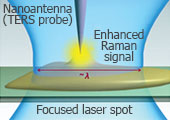
Application Note 100
pdf (2.8 Mb, EN)
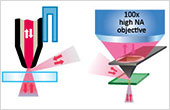
Application Note 099
Scanning near-field optical microscopy (SNOM) enables studying a sample’s optical properties with resolution far beyond the diffraction limit.
Sample fluorescence, light emission, transmission, scattering etc. can be mapped with the spatial resolution down to tens of nanometers.
pdf (2.2 Mb)
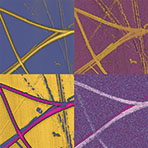
Application Note 098
pdf (6.2 Mb)
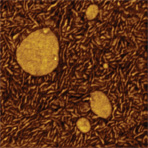
Application Note 097
Compositional imaging of heterogeneous materials with AFM is one of invaluable applications of this method in academy and industry. Visualization of specific structures and probing of local properties (mechanical, electric, thermal, spectroscopic, etc.) are employed for AFM compositional imaging.
pdf (6 Mb)
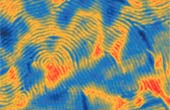
Application Note 096
Contact mode, introduced 30 years ago, is the pioneering AFM technique that is still a valuable partner for other methods. Local mechanical studies in contact mode are demonstrated on polymer blends. Mapping of electrostatic force response in contact mode helps to characterize the electrically-active materials.
pdf (3.3 Mb)
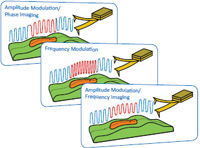
Application Note 095
A set of oscillatory resonance AFM modes is expanded with frequency modulation mode and frequency imaging in amplitude modulation mode. Frequency modulation mode provides a superior capability in imaging at broad force range and enhances studies at low probe-sample forces.
pdf (3.8 Mb)
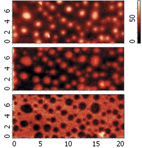
Application Note 094
AFM recognition of the individual components in heterogeneous polymer materials is usually based on their specific morphology and differences of local mechanical and electric properties. Nowadays a deficit of local chemical or spectral information in AFM can be overcome by combining it with confocal aman scattering microscopy.
pdf (2 Mb)
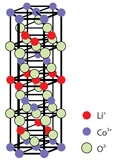
Application Note 093
Development of advanced lithium batteries currently represents a very rapidly growing field of science and technology. Lithium batteries are interesting as a power source in numerous portable devices such as notebook computers, cellular phones and camcorders, in electrical vehicles, in military and aerospace applications.
pdf (2.2 Mb)
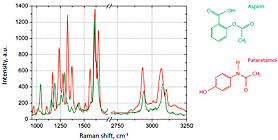
Application Note 092
Raman microscopy is a widely used technique in pharmaceutical industry. It allows identifying and rapidly characterizing chemical compounds, functional groups, molecular conformers, and authenticating various drugs.
pdf (1.9 Mb)
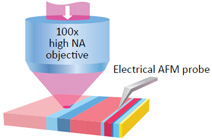
Application Note 091
The Sun is an abundant, easily accessible power source that is currently underutilized, will possibly become the no-alternative choice for electrical power of humankind. It is believed that the most promising way to convert solar power is by the photoelectric method used in solar cells (SCs).
pdf (1.6 Mb)
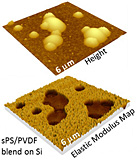
Application Note 090
Quantitative nanomechanical measurements of polymer samples in HybriD mode sho wed that the local elastic moduli correlate well to their macroscopic values.
Maps of elastic modulus were successfully applied for compositional mapping of immiscible polymer blends.
pdf (1.7 Mb)
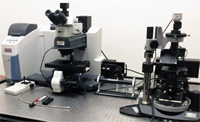
Application Note 089
Comprehensive materials characterization relies on studies of samples by complementary techniques. A need for chemical recognition of compounds at the microscopic scale led to the development of IR and Raman microscopes.pdf (3.3 Mb)
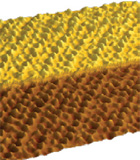
Application Note 088
An operation of AFM microscope in a temperature-stable cabinet facilitates high-resolution studies and makes molecular-scale imaging of different materials a routine procedure.
The imaging at the atomic and molecular scale has been achieved on a number of samples not only in contact mode but also in the oscillatory resonant (Amplitude Modulation) and non-resonant (HybriD) modes.
pdf (1.7 Mb)

Application Note 087
Enhanced visualization of nanoscale structures - one of remarkable features of the HybriD Mode.
High-resolution mapping of local adhesion and stiffness in the HybriD Mode expands AFM compositional mapping of heterogeneous materials and transforms it into quantitative analysis of local mechanical properties.
pdf (8.8 Mb)
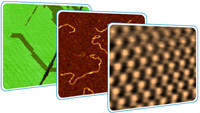
Application Note 086
pdf (3.6 Mb)